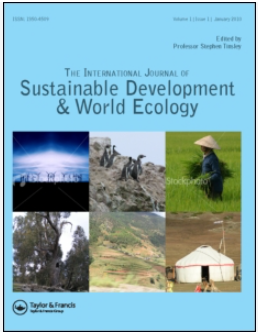探索城市空间形态与基础设施的尺度关系
IF 7.7
3区 环境科学与生态学
Q1 ECOLOGY
International Journal of Sustainable Development and World Ecology
Pub Date : 2022-06-10
DOI:10.1080/13504509.2022.2084796
引用次数: 2
摘要
影响城市基础设施规划设计的因素多种多样,但考虑到人口与基础设施的比例规律,城市人口通常是首要考虑因素。虽然城市物理空间形态和基础设施在物理上是相关联的,但它们的异速尺度尚未得到系统的解决。在这项研究中,我们研究了五种类型的基础设施,包括道路、供水管道、排水管道、公共汽车和学校,如何影响中国78个大城市的景观指标特征的城市空间形态。结果表明,城市基础设施与景观形态指数(LSI)、面积加权平均周长面积比(PARA_AM)和最大斑块指数呈比例关系。具体而言,在PARA_AM的平均值下,当LSI增加一倍时,道路面积增加约2.5倍。在相同人口规模下,空间形态更加碎片化的城市需要更多的基础设施投资,特别是道路和其他交通组成部分。研究表明,城市基础设施与景观指标呈超线性定量关系,城市形态越复杂,城市对基础设施的需求越大。虽然回归模型的系数存在较大差异,但其异速标度对城市基础设施的规划设计具有一定的指导意义。这将有助于将生态景观指标纳入城市规划和发展。本文章由计算机程序翻译,如有差异,请以英文原文为准。
Exploring the scaling relations between urban spatial form and infrastructure
ABSTRACT A variety of factors may affect the planning and design of urban infrastructure but urban population usually is the primary consideration given scaling laws between population and infrastructure. Although urban physical spatial form and infrastructure are physically attached, their allometric scaling has not been systematically addressed. In this study, we examine how five types of infrastructure, including roads, water supply pipelines, drainage pipelines, buses, and schools, affect urban spatial form characterized with landscape metrics derived for 78 large cities in China. The results suggest that urban infrastructure has scaling relations with landscape shape index (LSI), area-weighted mean perimeter-area ratio (PARA_AM), and largest patch index. Specifically, at the mean value of PARA_AM, road area increases about 2.5 times when doubling LSI. Under the same population size, cities with more fragmented spatial form need more investments in infrastructure, particularly roads and other traffic components. It is concluded that urban infrastructure experiences a super-linear quantitative relationship with landscape metrics, and a city with a more complex urban form spatially requires more infrastructure. The coefficients of the regression models show a lot of variations but the allometric scaling is meaningful for the planning and design of urban infrastructure. It will be helpful to incorporate ecological landscape metrics into urban planning and development.
求助全文
通过发布文献求助,成功后即可免费获取论文全文。
去求助
来源期刊
CiteScore
11.10
自引率
3.60%
发文量
58
审稿时长
18-36 weeks
期刊介绍:
The International Journal of Sustainable Development and World Ecology is now over fifteen years old and has proved to be an exciting forum for understanding and advancing our knowledge and implementation of sustainable development.
Sustainable development is now of primary importance as the key to future use and management of finite world resources. It recognises the need for development opportunities while maintaining a balance between these and the environment. As stated by the UN Bruntland Commission in 1987, sustainable development should "meet the needs of the present generation without compromising the ability of future generations to meet their own needs."

 求助内容:
求助内容: 应助结果提醒方式:
应助结果提醒方式:


